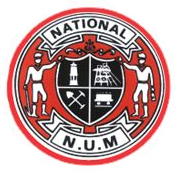Related Research Articles

The National Union of Mineworkers (NUM) is a trade union for coal miners in Great Britain, formed in 1945 from the Miners' Federation of Great Britain (MFGB). The NUM took part in three national miners' strikes, in 1972, 1974 and 1984–85. Following the 1984–85 strike, and the subsequent closure of most of Britain's coal mines, it became a much smaller union. It had around 170,000 members when Arthur Scargill became leader in 1981, a figure which had fallen in 2023 to an active membership of 82.

William Adamson was a Scottish trade unionist and Labour Party politician. He was Leader of the Labour Party from 1917 to 1921 and was Secretary of State for Scotland in 1924 and during 1929–1931 in the first two Labour ministries headed by Ramsay MacDonald.
The Miners' Federation of Great Britain (MFGB) was established after a meeting of local mining trade unions in Newport, Wales in 1888. The federation was formed to represent and co-ordinate the affairs of local and regional miners' unions in England, Scotland and Wales whose associations remained largely autonomous. At its peak, the federation represented nearly one million workers. It was reorganised into the National Union of Mineworkers in 1945.

Sir William Lawther was a politician and trade union leader in the United Kingdom.

The South Wales Miners' Federation (SWMF), nicknamed "The Fed", was a trade union for coal miners in South Wales. It survives as the South Wales Area of the National Union of Mineworkers.
Lawrence Daly was a coal miner, trade unionist and political activist.

The National Union of Scottish Mineworkers (NUSW) is a trade union in Scotland, founded in 1894 as the Scottish Miners Federation. It joined the Miners' Federation of Great Britain, and in 1914 changed its name to National Union of Scottish Mineworkers. It survives as the National Union of Mineworkers.
Sir Sidney Ford, MBE was a British trade union leader.
The Lanarkshire Miners' County Union, later the Lanarkshire Mineworkers' Union, represented coal miners in the Lanarkshire district of Scotland.
Joseph Robert Alwyn Machen was an English trade union leader who was president of the Yorkshire Area of the National Union of Mineworkers and posthumously elected president of the National Union of Mineworkers.
The North Wales Miners' Association was a trade union representing coal miners in Wales.
George Bolton is a Scottish former trade unionist and communist activist.

Abraham Moffat was a Scottish trade unionist and communist activist. He was elected repeatedly to high office in the trade unions and represented the union on government coal boards. He held major union offices: President of the National Union of Scottish Mine Workers; member of the executive committee of the Miners' Federation of Great Britain; Vice-chairman Scottish Regional Coal Board; and member National Coal Board. He served as president of the union from 1942 to his retirement in 1961, when he was succeeded by his younger brother Alex Moffat, also an activist.
Alexander B. Moffat was a Scottish trade unionist and communist activist who was President of the Scottish Trades Union Congress and the Scottish Mineworkers Union.

The Somerset Miners' Association or Somersetshire Miners' Association was a coal mining trade union based in the Somerset coalfield, Somerset, England.
The Mid and East Lothian Miners' Association (MELMA) was a trade union representing coal miners in parts of the Lothian area of Scotland.
The Stirling Miners County Union was a trade union representing coal miners in the Stirlingshire area of Scotland.
David Proudfoot was a Scottish trade unionist.
Herbert W. Booth was a British trade unionist.
The Warwickshire Miners' Association was a trade union representing coal miners in the Warwickshire area of England.
References
- ↑ W. H. Marwick, "A Short History of Labour in Scotland, p.27
- ↑ Alex Maxwell, Chicago Tumbles: Cowdenbeath and the Miners Strike, p.139
- ↑ Arthur Ivor Marsh and Victoria Ryan, Historical directory of trade unions, Volume 6, pp.510-511
- ↑ Report on Trade Unions in 1905-1907. London: Board of Trade. 1909. p. 82-101.
- 1 2 3 Arthur Ivor Marsh and Victoria Ryan, Historical Directory of Trade Unions, vol.6, p.492
- 1 2 "Adamson, William [Willie]", Oxford Dictionary of National Biography
- ↑ Matthew Worley, Class Against Class: The Communist Party in Britain Between the Wars, p.265
- ↑ Matthew Worley, Class Against Class: The Communist Party in Britain Between the Wars, p.124
- ↑ L. J. Macfarlane, The British Communist Party: Its Origin and Development Until 1929, p.265